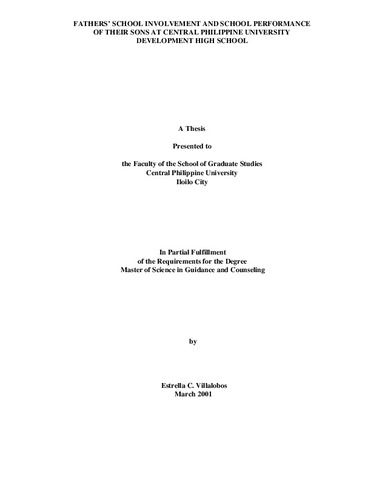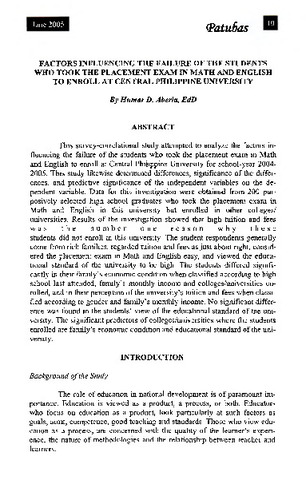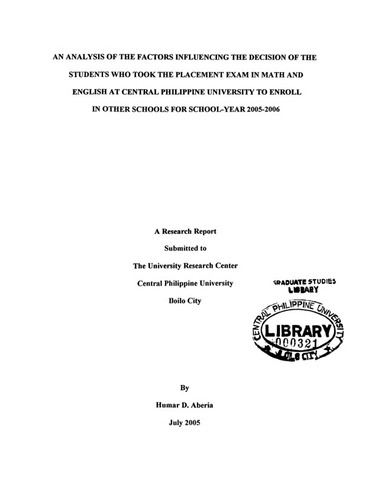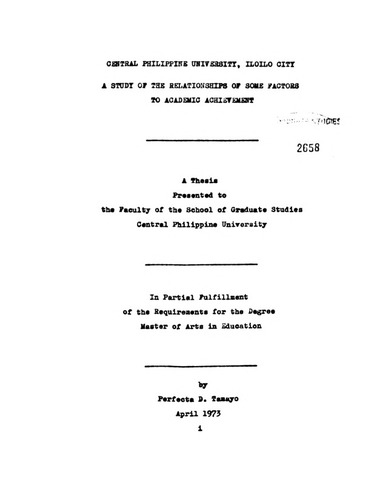Показать сокращенную информацию
Fathers’ school involvement and school performance of their sons at Central Philippine University Development High School
| dc.contributor.author | Villalobos, Estrella C. | |
| dc.date.accessioned | 2021-03-24T01:10:40Z | |
| dc.date.available | 2021-03-24T01:10:40Z | |
| dc.date.issued | 2001 | |
| dc.identifier.citation | Villalobos, E. C. (2001). Fathers’ school involvement and school performance of their sons at Central Philippine University Development High School (Unpublished Master's thesis). Central Philippine University, Jaro, Iloilo City. | en_US |
| dc.identifier.uri | https://hdl.handle.net/20.500.12852/658 | |
| dc.description | Abstract only | en_US |
| dc.description.abstract | This study focused on some factors associated with the fathers’ school involvement and the relationship between this involvement and the school performance of their sons at Central Philippine University Development High School. In a one-shot survey, questionnaires were administered to 232 male students randomly chosen from the different sections of first to fourth year levels. Distributions of variables under study were tested for normality and those to be correlated were tested for linearity of relationships. Since results showed that data distributions were skewed and the pairs of variables to be correlated did not display linear relationships, data were converted into ordinal ones and the Kendall tau was used to obtain the coefficients of correlation. A Kruskall Wallis Test was used to analyze the differences in the fathers’ involvement in general with regards to their ages. A Mann-Whitney U Test was used to analyze the differences in Direct Reinforcement of Improved Academic Performance (DRIAP) scores among the different age levels of the fathers. The mean final grade of the student respondents was 81.3 percent, which fall under the category of average. One-fourth of the respondents had above average and high grades. One-third had average grades, while 37.5 percent had below average grades. Only a few got failing grades. The age of the fathers/father-substitutes of the respondents ranged from 18 to 89 years, with more than half of them in the 41-50 age bracket. Half of them were employed full-time, one-fourth were self-employed, and 14 percent were holding at least two jobs. Almost 15 percent were unemployed and employed part-time. Most of the fathers were college graduates, and almost eight percent had postgraduate degrees. More than half were home most nights of the week. The majority of the fathers were perceived by their sons to be giving some form of support in their schooling. Half were perceived to be giving active support, and almost nine percent to be giving extremely active support. Only around 10 percent were thought of as non-supportive and extremely non-supportive. Of the four characteristics of the fathers that were taken into consideration (age, highest educational attainment, employment status, and average number of days per week when they are home), only the highest educational attainment was found to be significantly related to the level of their school involvement. When fathers were taken together as an entire group, a positive but low and insignificant relationship between their total school involvement and their sons' school performance was noted. The DRIAP (Direct Reinforcement of Improved Academic Performance) component, though, had a positive and significant relationship with school performance. When fathers were classified according to age, a positive and significant relationship between school performance of their adolescent sons and the VEI (Verbal Encouragement and/or Interaction) and DRIAP components of school involvement of fathers who were 40 years old and below was found. There was also a significant positive correlation between school performance and the DRIAP of fathers who were 41-50 years old. Among fathers of the remaining age brackets, there was no significant relationship at all between school performance and fathers’ school involvement, regardless of whether school involvement is taken as a whole or taken by its components. When fathers were classified according to their highest educational attainment, it was only the DRIAP (Direct Reinforcement of Improved Academic Performance) component of school involvement that was found to be significantly related to the boys' school performance, and this was true only among fathers who finished college. When fathers were classified according to employment status, it was only among fathers who were employed full-time and employed part-time where there was a significant correlation between DRIAP and school performance. When fathers were classified according to the average number of days per week when they were home, it was only in the case of fathers who were home for one or no night of the week when the fathers’ DRIAP (and none else of the other components of school involvement) was significantly related to their sons’ school performance. Conclusions The findings of the study led to the following conclusions: The fathers’ involvement in the schooling of their adolescent sons is related to their highest educational attainment, but not to their age, employment status, and the number of days per week when they are home. There is no relationship between the fathers’ school involvement and the school performance of their adolescent sons when fathers are taken together as a whole group, except the DRIAP (Direct Reinforcement of Improved Academic Performance) component. When fathers are classified according to their age, highest educational attainment, employment status and number of days per week when they are home, there is no significant relationship between school involvement and school performance when school involvement is taken in its entirety. But when school involvement is considered according to its components, it was found that it is the Verbal Encouragement and/or Interaction (VEI) and the Direct Reinforcement of Improved Academic Performance (DRIAP) of fathers who are 40 years old and younger, the DRIAP of fathers who are employed full-time and part-time, the DRIAP of fathers who are college graduates, and the DRIAP of fathers who are home 0-1 day per week which are significantly related to their sons’ school performance. Recommendations Based on the findings of the study, the following recommendations are proposed: 1. Fathers should give liberal doses of DRIAP (Direct Reinforcement of Improved Academic Performance) to their sons in high school because this shows to be the component of their school involvement that is significantly related to their sons’ school performance. They should reward their sons’ efforts to improve their grades by their verbal and non-verbal recognition and appreciation of it, as well as by cash and other material rewards. 2. Since this study shows that there is no significant relationship between fathers’ school involvement and school performance of their adolescent sons except their DRIAP, and considering the findings of two studies reviewed by Griffith which suggested that parental involvement is more beneficial to younger (elementary) students than to older (middle and high school) students, it may be important for fathers to remember to get involved with their sons’ schooling while these sons are still in the elementary grades, when their school involvement can still have a lot of impact on the sons’ school performance. When these sons have developed healthy study habits and good attitudes toward school through the early influence of their fathers, the fathers do not have to worry much about their sons’ school performance anymore. They just have to provide continued encouragement and reinforcement. 3. Studies on other types of school involvement that may have a significant effect on male adolescents’ school performance should be conducted. For example, in one of the studies reviewed in Chapter 2 regarding a certain school written about by Armbrister in the November 1991 issue of Reader’s Digest, parents ran concession stands al games, worked as tutors, volunteered time at the library, chaperoned field trips, had a strong input in preparing the school handout and determining the dress code, among other things, and their children performed very well in school. 4. in future studies, other factors that may affect male high school students’ school performance should be looked into. For example, studies could be made regarding the effect on school performance of peer pressure, the altitudes and teaching styles of teachers as perceived by the students, and the school environment, including the proliferation of billiard halls and computer games in close proximity to the campus. 5. The results of this study must be disseminated to fathers. This may be done through a report to be given during PTA meetings, a letter sent to fathers, or a sort of Fathers-and-Sons Day to be held in coordination with the school administration and the Guidance Services Center. | en_US |
| dc.format.extent | xv, 77 leaves | en_US |
| dc.language.iso | en | en_US |
| dc.subject.ddc | GSL Theses 371.4072 V7110 | en_US |
| dc.subject.lcsh | Academic achievement | en_US |
| dc.subject.lcsh | Fathers and sons | en_US |
| dc.subject.lcsh | Father and child | en_US |
| dc.subject.lcsh | Central Philippine University | en_US |
| dc.subject.lcsh | Central Philippine University--Students | en_US |
| dc.subject.lcsh | High school students | en_US |
| dc.subject.lcsh | Education--Parent participation | en_US |
| dc.subject.lcsh | Education, Secondary--Parent participation | en_US |
| dc.subject.lcsh | Sons | en_US |
| dc.subject.lcsh | Fathers | en_US |
| dc.subject.mesh | Fathers | en_US |
| dc.subject.mesh | Father-Child Relations | en_US |
| dc.subject.mesh | Academic Performance | en_US |
| dc.title | Fathers’ school involvement and school performance of their sons at Central Philippine University Development High School | en_US |
| dc.type | Thesis | en_US |
| dc.description.bibliographicalreferences | Includes bibliographical references | en_US |
| dc.contributor.chair | David, Fely P. | |
| dc.contributor.committeemember | Caipang, Marjorie A. | |
| dc.contributor.committeemember | Catalogo, Lucy M. | |
| dc.contributor.committeemember | Suyo, Perla A. | |
| dc.contributor.committeemember | Chin, Fely P. | |
| dc.contributor.committeemember | Navarra, Victor E. | |
| dc.contributor.department | School of Graduate Studies | en_US |
| dc.description.degree | Master of Science in Guidance and Counseling | en_US |
| local.subject | Central Philippine University (CPU). Junior High School. | en_US |
| local.subject | Central Philippine University (CPU). Development High School. | en_US |





